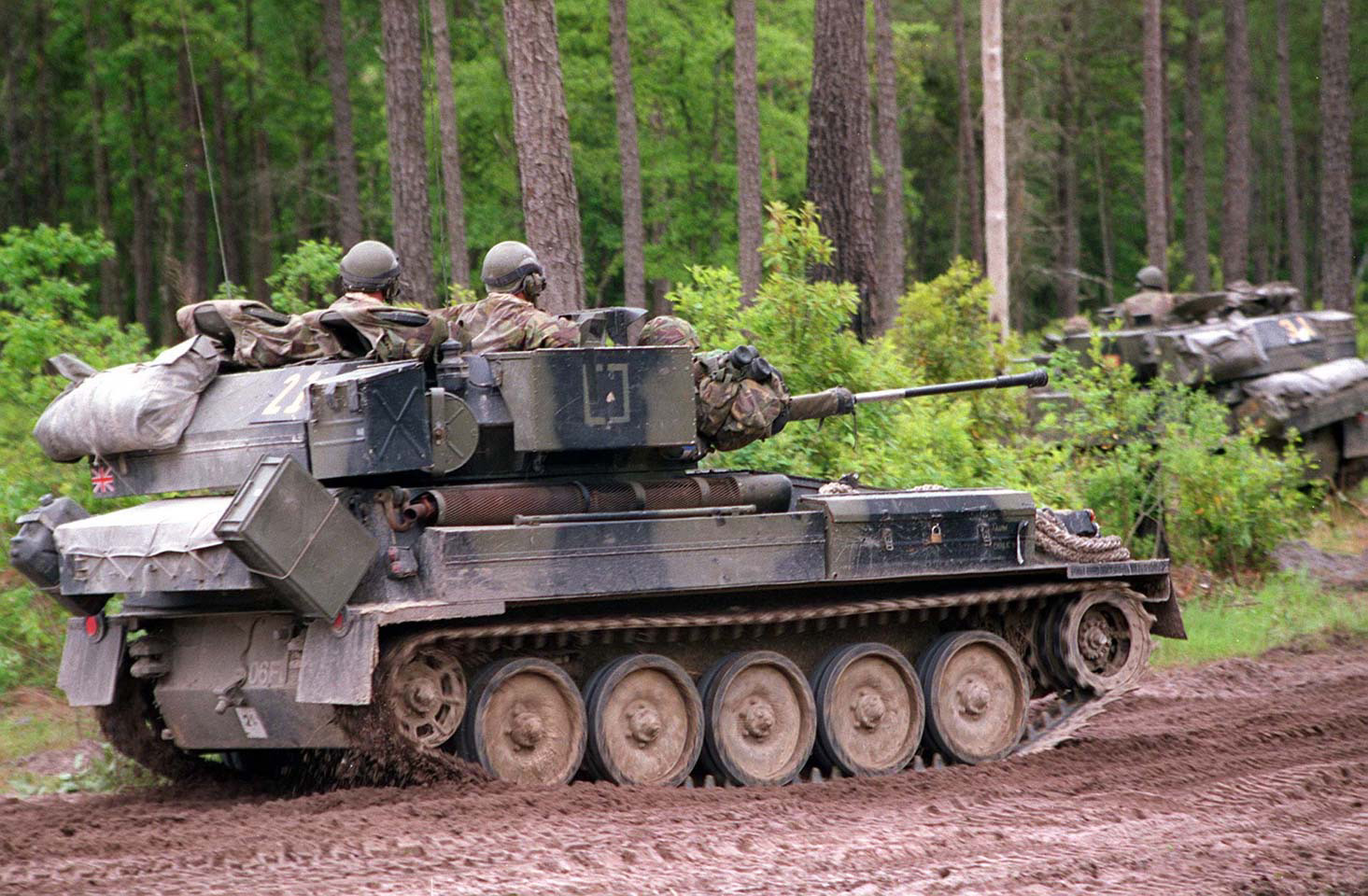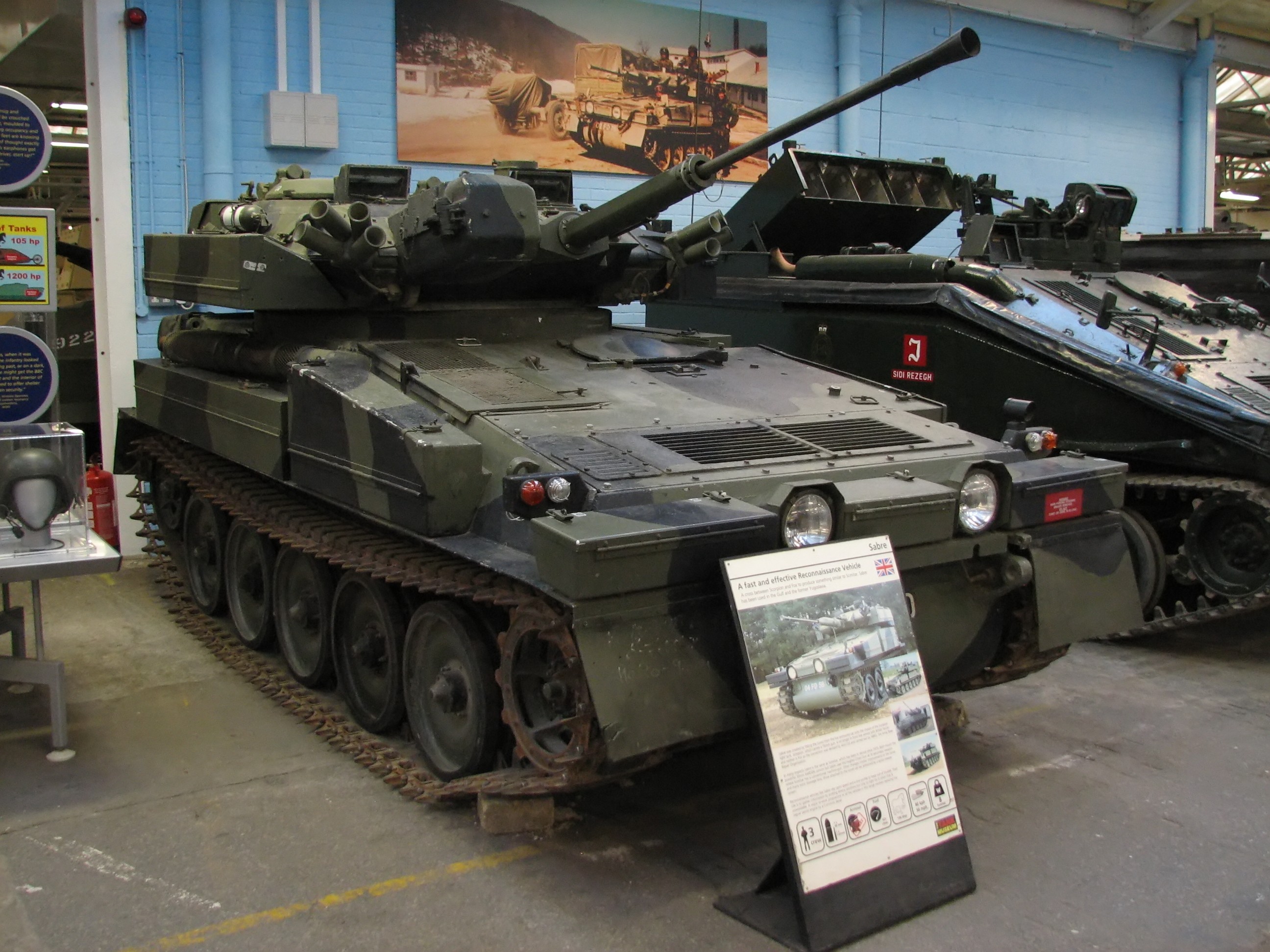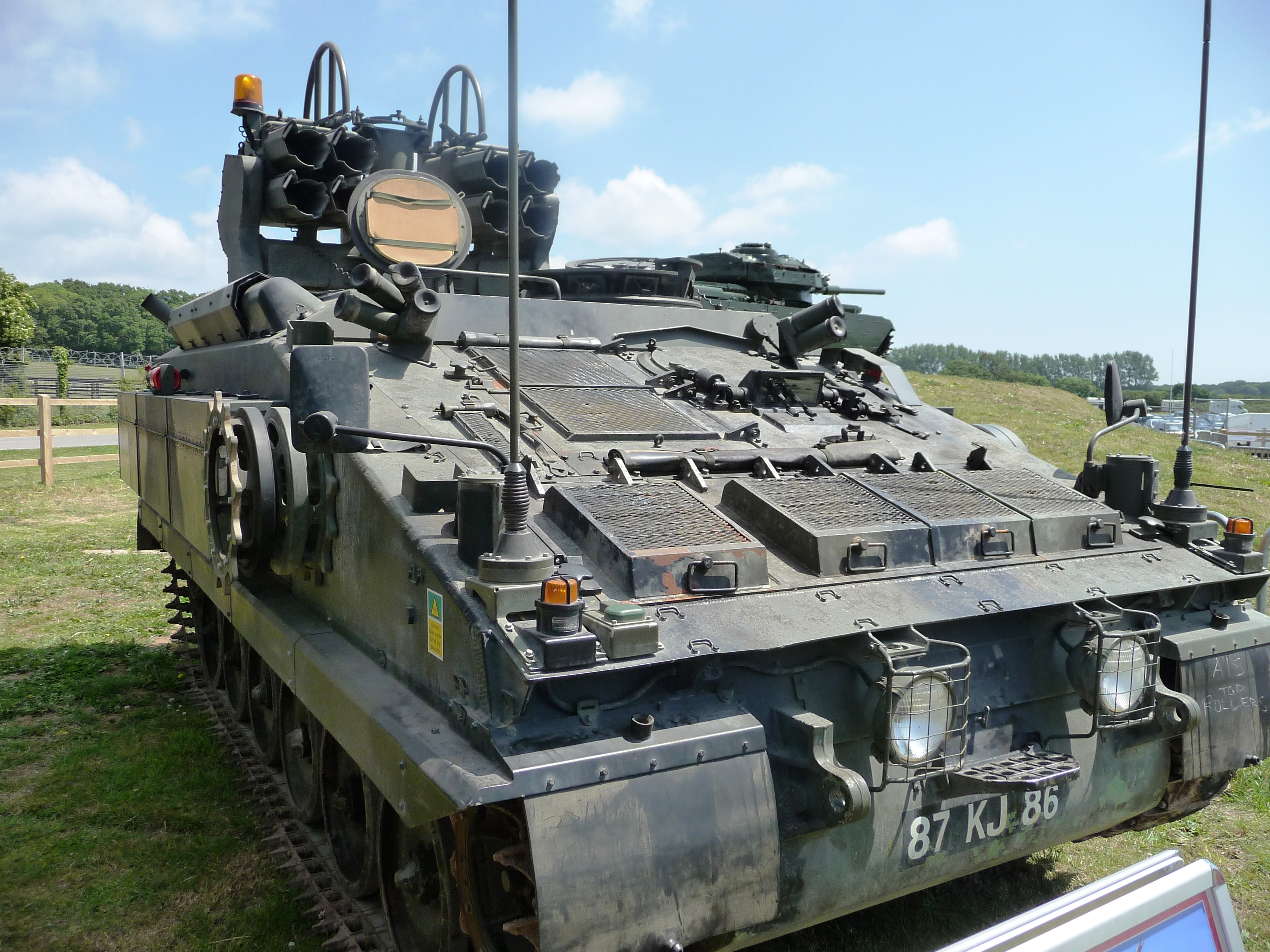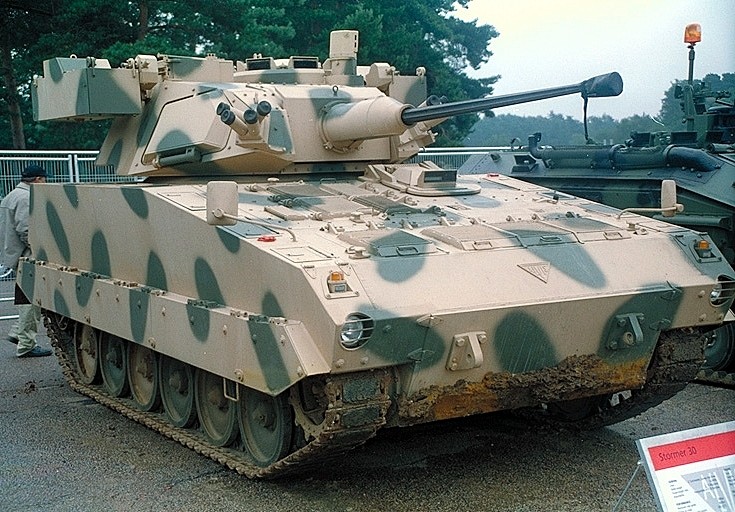The Combat Vehicle Reconnaissance (Tracked) —or CVR(T)—is a family of armoured fighting vehicles (AFV)s in service with the British Army and others throughout the world. They are small, highly mobile, air-transportable armoured vehicles designed to replace the Alvis Saladin armoured car.
First designed by Alvis in the 1960s, the CVR(T) family includes Scorpion and Scimitar light reconnaissance tanks, Spartan armoured personnel carriers (APC)s, Sultan command and control vehicle, Samaritan armoured ambulance, Striker anti–tank guided missile vehicle and Samson armoured recovery vehicle. All members of the CVR(T) family were designed to share common automotive components and suspension; aluminium armour was selected to keep the weight down. By 1996 more than 3,500 had been built for British Army use and export.
Scorpion and Striker have now been withdrawn from British Army service. Scimitar and Spartan are expected to be replaced by newer vehicles from the Future Rapid Effect System programme and the Panther Command and Liaison Vehicle. Army 2020 armoured cavalry units however are stated to be equipped with Scimitars.
---------------------------------------------------------------------------------------------------------------------------------------------------------------------------------------------
FV101 Scorpion (Armoured Reconnaissance Vehicle)

Introduction
The FV101 Scorpion is a British armoured reconnaissance vehicle. It was the lead vehicle and the fire support type in the Combat Vehicle Reconnaissance (Tracked), CVR(T), family of seven armoured vehicles. Manufactured by Alvis, it was introduced into service with the British Army in 1973 and served until 1994. More than 3,000 were produced and used as a reconnaissance vehicle or a light tank. It holds the Guinness world record for the fastest production tank; recorded doing 82.23 kph (51 mph) at the QinetiQ vehicle test track, Chertsey, Surrey, on 26 March 2002
History
The Alvis Scorpion was originally developed to meet a British Army requirement for the Combat Vehicle Reconnaissance (Tracked) or CVR(T). In 1967, Alvis was awarded the contract to produce 30 CVR(T) prototypes. Vehicles P1–P17 being the Scorpion prototypes were delivered on time and within the budget. After extensive hot and cold weather trials in Norway, Australia, Abu Dhabi and Canada, the Scorpion was accepted by the British Army in May 1970, with a contract for 275, which later rose to 313 vehicles. The first production vehicles were completed in 1972 and the first British regiment to be equipped with the Scorpion was the Blues and Royals of the Household Cavalry in 1973. In November 1981, the RAF Regiment took delivery of its first Scorpions.
Alvis built more than 3,000 Scorpion vehicles for the British Army, Royal Air Force Regiment and the export market.
All the CVR(T) vehicles were to be air-portable; and two Scorpions could be carried in a C130 Hercules. Another requirement of the CVR(T) project was the low ground pressure - similar to that of a soldier on foot - this would serve it well in the boggy conditions of the Falklands War.
The Scorpion was retired from active use in 1994 by the UK.
Manufacturer: Alvis Vehicles Ltd, Coventry, England
Weight: 17,800 lb (8.074 tonnes)
Length: 5.288 m (17 ft 4.2 in)
Width: 2.134 m (7 ft 0 in)
Height: 2.102 m (6 ft 10.8 in)
Crew: 3
Armour: 12.7 mm welded aluminium
Main armament: ROF 76mm L23A1 gun (90 mm in Scorpion 90)
Secondary armament: Coaxial 7.62 mm L43A1 machine gun
Engine: Cummins BTA 5.9-litre (diesel) 190 hp (140 kW)
Power/weight: 22.92 hp/tonne
Transmission: David Brown TN15
Suspension: Torsion-bar
Operational range: 756 km (470 mi)
Speed: 72.5 km/h (45.0 mph)
---------------------------------------------------------------------------------------------------------------------------------------------------------------------------------------------
FV102 Striker (Anti-Tank Guided Missile Carrier)
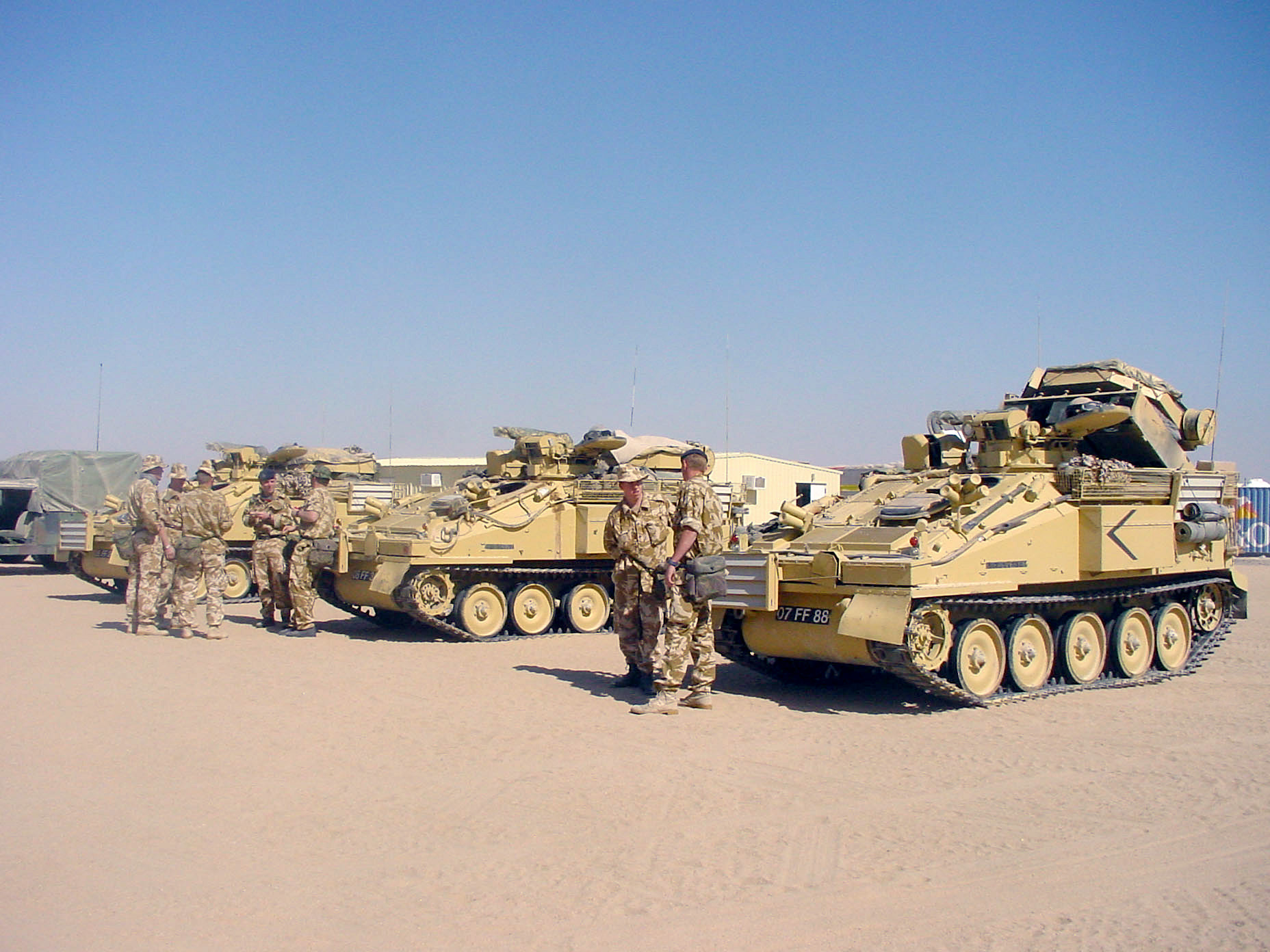
Introduction
The FV102 Striker was the anti-tank guided missile carrier in the CVR(T) family and served in the British Army.
Overview
FV102 Striker was the Swingfire wire guided anti-tank missile carrying member of the CVR(T) family. The FV102 Striker was externally very similar to the FV103 Spartan but carried five missiles in a ready-to-fire bin at the back of the vehicle. Five reload missiles were carried in the vehicle. The bin was elevated to 35º (622mils) for firing. The targeting sight could be demounted and operated at a distance from the vehicle which could remain in cover, even completely screened as the missile can turn up to 90 degrees after launch to come onto the target heading. The missiles were originally steered by joystick control using manual command to line of sight (MCLOS). This was later updated to the semi-automatic command to line of sight (SACLOS) system where the controller merely sights the target. Secondary armament was a general purpose machine gun.
Development
The Striker was developed for the British Army to fire the Swingfire missile. The first production vehicles were delivered in 1975 and used in British Army service by the Royal Artillery anti-tank guided missile batteries. The vehicle initially was powered by the Jaguar J60 4.2-litre 6-cylinder petrol engine - the same as used by several Jaguar cars. This was then replaced by a Cummins BTA 5.9 diesel engine as used in British Army Scimitars, under the CVR(T) life extension programme.
Service History
Striker entered service in 1976 with the Royal Artillery of the BAOR, but since then have been transferred to the Royal Armoured Corps where they served in formation reconnaissance regiments. The FV102 Striker was withdrawn from British Army service as the Swingfire missile was replaced by the Javelin missile in mid-2005.
Manufacturer: Alvis
Weight: 8.1 tonnes
Length: 4.8 m
Width: 2.4 m
Height: 2.2 m
Crew: 3
Main armament: Swingfire in five bins with 5 reloads
Secondary armament: 1 x 7.62 mm L7 GPMG
Engine: Cummins BTA 5.9-litre diesel. 190 hp (142 kW)
Suspension: torsion bar
Speed: 80 km/h (49.7 mph)
Ground clearance: 0.35 m
---------------------------------------------------------------------------------------------------------------------------------------------------------------------------------------------
Alvis FV103 Spartan (Armoured Personnel Carrier)
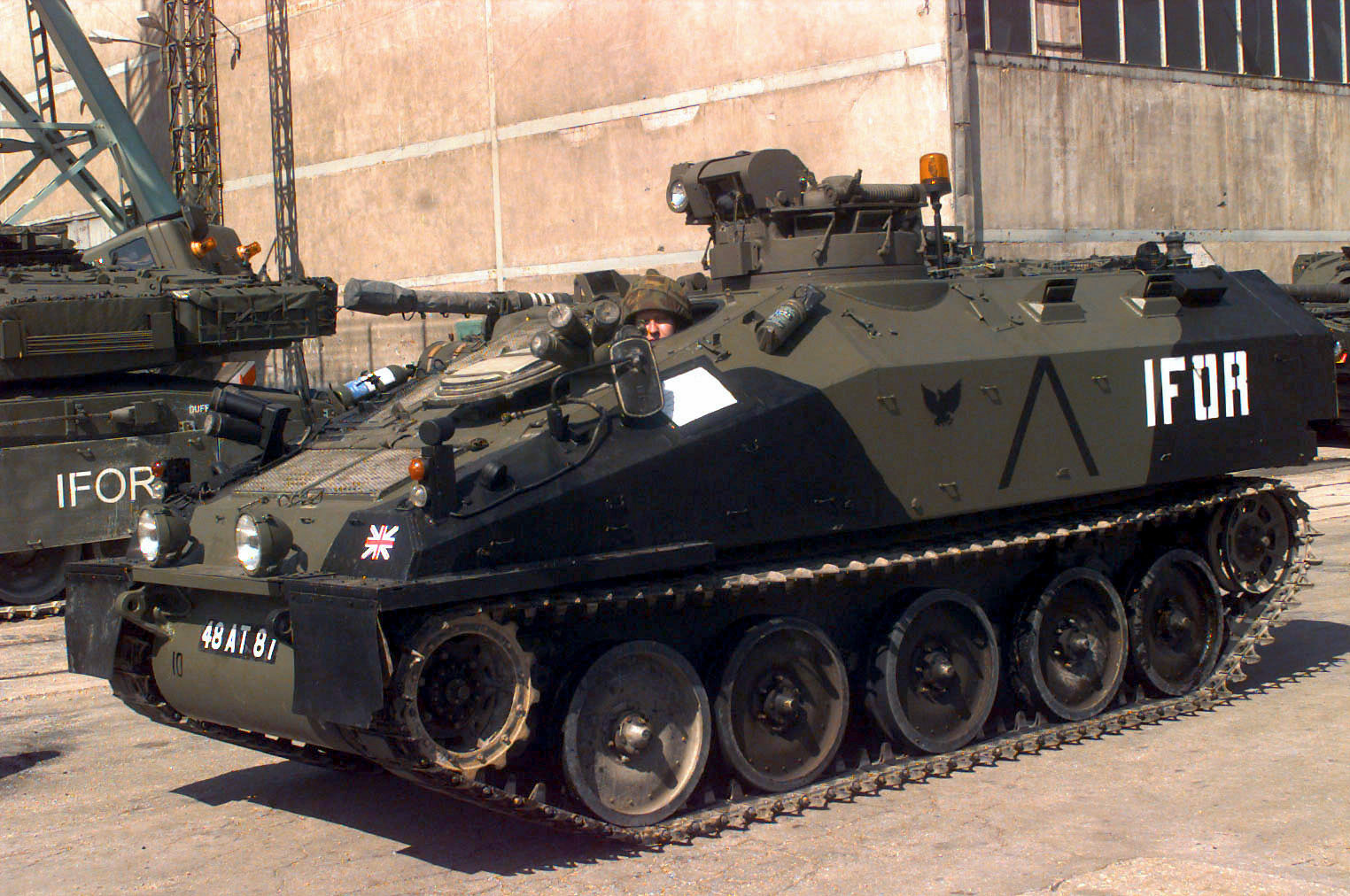
Introduction
The Alvis FV103 Spartan is a tracked armoured personnel carrier of the British Army. It was developed as the APC variant of the Combat Vehicle Reconnaissance (Tracked) family. The vehicle can carry up to 7 personnel, including 3 crew members. Armed with a single machine gun, it is almost indistinguishable from the FV102 Striker in external appearance. Rather than a general personnel carrier for infantry, the Spartan has been used for moving specialist teams, such as anti-aircraft missile teams. An anti-tank variant of the Spartan has been produced, named FV120 Spartan MCT; this is armed with MILAN anti-tank missiles. Nearly 500 Spartans have served with the British armed forces since entering service in 1978; they are now being replaced by newer vehicles.
Design and features
The FV103 Spartan was developed during the 1970s as the Armoured Personnel Carrier (APC) version of the British Army's Combat Vehicle Reconnaissance (Tracked) (CVR(T)) family of armoured fighting vehicles, designed by Alvis plc. The vehicle entered service with the British military in 1978. The Spartan is similar in appearance to the FV102 Striker, except for the missile launcher on the Striker.
The FV103 Spartan is powered by a Bedford 600 6-cylinder diesel engine, or a Cummins BT 5.1 engine. The vehicle is 5.16 metres (16.9 ft) in length and 2.48 metres (8 ft 2 in) in width. With a ground clearance of 0.33 metres (1 ft 1 in), it has a height of 2.63 metres (8 ft 8 in). As the APC variant of the CVR(T) family, the FV103 has been used by small specialized groups such as mortar fire controller teams, anti aircraft teams and also reconnaissance teams. The vehicle can carry 7 personnel, as a combination of 3 crew members and 4 passengers or 2 crew members and 5 passengers. It is armed with one 7.62 mm L37A1 machine gun, and can have four smoke dischargers on each side. In addition to the APC role, it has also been used as a resupply vehicle for the FV102 Striker, carrying extra Swingfire missiles. The FV103 has combat weight of 10,670 kilograms (23,520 lb). It can achieve a maximum speed of 96 kilometres per hour (60 mph) and has a range of 510 kilometres (320 mi). It is capable of negotiating up to 60% gradients.
Variants and service
An anti-tank variant of the FV103 was produced, named FV120 Spartan MCT (Spartan with MILAN Compact Turret). The FV120 has a two-man turret, and is equipped with two MILAN Anti-Tank Light Infantry Missiles in launch positions, while 11 more can be carried internally.
It was reported to the House of Commons in 2006 that 478 FV103 vehicles were in service with the armed forces of the United Kingdom in April of that year, with 452 of them in deployable state. By 2007, 495 FV103 Spartans were in the service of the United Kingdom. However, these were being replaced by mid-2009 with Panther Command and Liaison Vehicles.
Type: Armoured personnel carrier
Place of origin: United Kingdom
Weight: 10,670 kilograms (23,520 lb) 9 ton 55 lbs Battle weight
Length: 5.16 metres (16.9 ft)
Width: 2.48 metres (8 ft 2 in)
Height: 2.63 metres (8 ft 8 in)
Crew: 3, with 4 passengers
Main armament: 1 x 7.62 mm GPMG
Engine:
Jaguar J60 4.2 litre DOHC inline six petrol 252 lbs/ft @ 3000rpm
190 hp @ 4500rpm(142 kw)
Current vehicles are fitted with Cummins 6BT diesel
Power/weight: 17.9 hp/t
Suspension: Torsion bar
Operational range: 510 kilometres (320 mi)
Speed: 96 kilometres per hour (60 mph)






